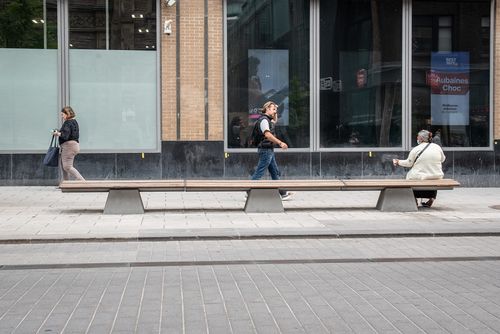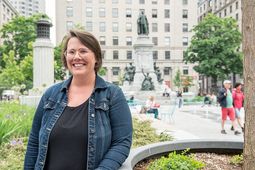
For equitable sharing of public spaces with homeless people
What daily itineraries do people experiencing homelessness take in Montreal? And how does society contribute – through urban spatial planning practices – to their inclusion or exclusion from public space?
These are the big questions being asked by the University of Montreal students and research collaborators Architecture Without Borders Quebec (ASFQ)Sarlo Wagner-Lapierre, Elisabeth Prince and Véronique LaPalme attempt the answer this summer under the direction of Professor Caroline Grimard, of the UdeM School of Social Work, and Sonia Blank, a UdeM-graduated architect and researcher of urban solidarity indoors. ASFQ.
More specifically, the research team is interested in people who move to outdoor public spaces and make them “home,” whether on the streets, in parks, or in urban campsites. The team seeks to learn about their personal stories, assess their needs, and identify planning practices that prove to be the most inclusive.
Understand the complexity of homelessness
Caroline Grimard
Credit: Amelie Philibert | University of Montreal
By combining social action and architecture, this interdisciplinary project will enable the identification of gestures and combinations to be preferred in terms of planning and urban development, in the context of collaborative thinking, in particular with the city of Montreal.
“One of the advantages of this project is the diversity – and integration – of disciplines,” emphasizes Caroline Grimard. By pairing students trained in social work with others who have studied architecture, we have on the one hand people who will meet homeless people to hear their needs and translate them to other members of the team. Development An urban that will not be hostile to homelessness.”
After the first search
Funded by the Social Sciences and Humanities Research Council (SSHRC), the Metropolitan Initiative and the Outreach Fund of the Ministry of Municipal Affairs and Housing, as well as the City of Montreal, this project is the result of first research developed by Caroline Grimard in collaboration with the ASFQ.
This first project made it possible to document different practices in terms of architecture, design and urbanism for people experiencing homelessness, both in Western Europe and in the United States and Canada.
“Our work has made it possible to identify facilities that are hostile to people experiencing homelessness, but also many others that are less or not at all opposed to it,” insists Caroline Grimard. We’ve grouped this into five broad categories of design practices that can support the well-being of people experiencing homelessness.”
The results of their work are listed in a catalog titled Architecture + Roaming: Inclusive Practices for a Unified Cityannounced in January and intended for decision makers in order to increase their awareness and provision of mixed use in the development of development projects in Montreal.
Guided tour of the facilities, St Catherine Street
Quiet promenade
Credit: Amelie Philibert | University of Montreal
Accompanied by Sonia Blanc, invited Caroline Grimard UdeMNews To see the good and bad developments – and redevelopment – along St Catherine Street, from Phillips Square, to the west, to Emilie Gamelin Square, to the east.
Square Phillips was only redeveloped a few years ago, and it is still a heat island because the trees that were planted there are not yet mature, but the street furniture is no longer as hostile to homeless people as it used to be. For example, the new seats no longer have a central armrest, which prevents people from reclining.
Likewise, container lids, which prevented people from picking up bottles and cans that could be returned, were modified to make the process easier.
At this point in the march, we see the decoration of the development, notably through the renewal of the neighborhood red lightand see few homeless people.
Caroline Grimard explains that “public space is a place of coexistence and coexistence inevitably creates tensions. Grudgement has the effect of displacing the community services that make up the social fabric of homeless people. When architecture is used to create a harmonious ideal, it benefits one group more than another, It makes some people invisible and excludes them.”
Le Repaire’s multi-purpose pavilion and Esplanade Tranquille, in the Quartier des Spectacles, is a good example of mixed-use developments. The pavilion and the balcony offer different types of spaces and activities within everyone’s reach, in winter and summer. Schedules allow students to work as a team, bean bags It gives both tourists and hikers the chance to rest for a few moments. And if necessary, the ward staff can contact a reference association if requested by the touring persons.
“In contrast, Place Hydro-Québec is also a good architectural movement which, with its street furniture in shaded areas that includes a water point, promotes diversity with its intimate and safe areas,” adds the master.
After Saint-Laurent Street, continuing east, we note that places to share are becoming scarce. However, the organization Backpack It is the origin of a building project, located on the corner of rue Sainte-Élisabeth, which will offer various services and social housing for homeless clients. Attend the Montreal cactus It also plays an important role, both for the health of homeless people and for the residents of the neighborhood.
Once you get to Place Émilie-Gamelin, you see that the development conflicts are much more apparent. The tower construction project, the closure of many businesses, and the pandemic have made the entire neighborhood more hostile to the homeless.
“Working on social coexistence isn’t about eliminating conflicts of use, or even conflicts at all: it’s about teaching groups to live together and making sure that conflicts don’t arise from an unmet need,” says Caroline Grimard. If people are going to defecate in someone’s yard, It may be because there are not enough public toilets.
Post-professional survey is coming
At the end of this summer research project, a post-professional survey should be conducted in order to identify the uses of the interior spaces and to understand the use made by people experiencing homelessness when completing architectural and design work.
“This new research project will allow us to check whether their realities have been taken into account and whether the well-being-promoting practices that emerged from our analysis are reflected in development projects in Quebec,” concluded Caroline Grimard. We also want to check that design projects do not feed into existing trauma among users: this is an area of research that is being talked about more and more in health practices.

“Organizer. Social media geek. General communicator. Bacon scholar. Proud pop culture trailblazer.”


